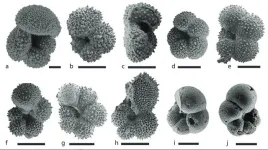(Press-News.org) Ravinder Bhatia, a leader and engineer with three decades of experience managing collaborative science initiatives, is the new head of ITER projects at the U.S. Department of Energy’s Princeton Plasma Physics Laboratory (PPPL).
In this role, Bhatia oversees the design and fabrication of six diagnostic systems, or sensor systems, that PPPL is building for ITER, the multinational facility under assembly in France to study plasma that can heat itself and sustain its own fusion reactions. The diagnostics will observe the plasma within ITER to measure properties that include temperature, density, and rotation speed, and ultimately increase the efficiency of the fusion reactions.
“I am delighted to serve in this leadership role of guiding and collaborating with the ITER team across the US and the international partnership,” said Bhatia. “I’m pleased the efforts of the entire team working alongside me have been recognized.”
“I am thrilled that Ravinder has taken on this important role at the Lab, as this is a critical project for PPPL,” said Mike Ford, PPPL’s associate laboratory director for engineering. “His years of experience with complex research and technology projects and his familiarity with PPPL make him an excellent fit, and we are confident he will lead the team to success.”
Bhatia has extensive experience with the ITER project at PPPL. As deputy head of ITER Group, he deepened the strategic partnerships with the US ITER project based at Oak Ridge National Laboratory, the ITER Organization in France, US ITER subcontractors and ITER partners around the world, including leading international efforts to coordinate development of the mirrors and cleaning systems for the optical components that face the intense heat from the plasma. As interim head of the ITER diagnostics department, he led the reorganization of PPPL’s ITER team. He also spearheaded the completion of the program re-baseline and the execution of the new plan.
Contributing to a major multinational effort
ITER is expected to produce conditions that generate self-heated burning plasma, a state in which the dominant source of heat for the plasma are the fusion reactions themselves.
“PPPL’s diagnostics are critical to the ITER project’s success,” Bhatia said. “The information they gather will help optimize high-power plasma performance and aid the design of future fusion reactors, in turn supporting eventual commercialization of fusion power. Our role is very important.”
But Bhatia views ITER more as just a technological endeavor. “I also see my role within the ITER project as helping bring countries together in a peaceful science initiative,” he said, “and I hope that through this project we can foster channels of communication to support cooperation, engagement, dialogue and understanding.”
A succession of successes
Before arriving at PPPL, Bhatia was involved in several significant projects spanning subjects ranging from astronomy to astrophysics to oceanography, including the Thirty Meter Telescope, and the Atacama Large Millimeter/Submillimeter Array (ALMA) observatory. As a Senior Engineer at the European Space Agency, he helped design parts of the Planck Space Telescope and supported the development of the Mid-Infrared Instrument (MIRI) camera for the James Webb Space Telescope.
Bhatia earned his bachelor’s degree in aeronautics from Imperial College in 1991 and his Ph.D. in experimental astrophysics and aerospace engineering from Queen Mary College in 1998. He earned a master’s degree in international relations from Cambridge University in 2005, and is a Senior Member of the American Institute for Aeronautics and Astronautics.
Bhatia lives in Sierra Madre, in Southern California, by the San Gabriel mountain range and the Angeles National Forest, with bears, bobcats and red-tailed hawks. In his spare time, he enjoys a variety of outdoor activities, including cycling, hiking, and spending time at the ocean. He also volunteers as a soccer referee for kids ages 8-14. “Being a referee is an opportunity for me to contribute to my community, which has supported my family coming to the United States as immigrants and welcomed us,” Bhatia said. He also volunteers on Saturdays at a food bank, preparing boxes of food for donation to low-income families and the homeless.
About US ITER
US ITER is managed by Oak Ridge National Laboratory with partner labs Princeton Plasma Physics Laboratory and Savannah River National Laboratory. DOE Laboratories, universities, and industry contribute hardware design, testing, and fabrication to the project.
PPPL is mastering the art of using plasma — the fourth state of matter — to solve some of the world's toughest science and technology challenges. Nestled on Princeton University’s Forrestal Campus in Plainsboro, New Jersey, our research ignites innovation in a range of applications, including fusion energy, nanoscale fabrication, quantum materials and devices, and sustainability science. The University manages the Laboratory for the U.S. Department of Energy’s Office of Science, which is the nation’s single largest supporter of basic research in the physical sciences. Feel the heat at https://energy.gov/science and http://www.pppl.gov.
END
Bhatia named new head of ITER projects at PPPL
2024-06-13
ELSE PRESS RELEASES FROM THIS DATE:
The Davos Alzheimer’s Collaborative launches global effort to streamline diagnosis of Alzheimer’s disease and related dementias
2024-06-13
The Davos Alzheimer’s Collaborative (DAC), the global organization seeking to cure Alzheimer’s disease and dementia, today announced a new initiative in health systems in five countries to deploy blood biomarkers (BBMs) and confirmatory diagnostic testing to increase timely and accurate diagnosis of Alzheimer’s disease and related dementias (ADRD). Led by the DAC Healthcare System Preparedness (DAC-SP) team, the Accurate Diagnosis project is the first-ever global implementation research program to study the use of blood biomarkers as part of the ADRD diagnostic ...
Nanosized blocks spontaneously assemble in water to create tiny floating checkerboards
2024-06-13
Researchers have engineered nanosized cubes that spontaneously form a two-dimensional checkerboard pattern when dropped on the surface of water. The work, published in Nature Communications, presents a simple approach to create complex nanostructures through a technique called self-assembly.
“It’s a cool way to get materials to build themselves,” said study co-senior author Andrea Tao, a professor in the Aiiso Yufeng Li Family Department of Chemical and Nano Engineering at the University of California San Diego. “You ...
University of Colorado co-leads multicenter randomized trial identifying method of emergency intubation preoxygenation to decrease risk of hypoxemia and cardiac arrest
2024-06-13
In current clinical care, most critically ill adults undergoing emergency tracheal intubation receive preoxygenation through an oxygen mask. Administering supplemental oxygen to patients prior to the start of an intubation procedure increases the oxygen content in the patient’s lungs and decreases the risk of hypoxemia, low levels of oxygen in the blood. However, hypoxemia occurs during 10% to 20% of tracheal intubations in the emergency department or intensive care unit and may lead to cardiac arrest and death.
The University of Colorado co-led a trial with Vanderbilt University that compared the two most ...
Quantum data assimilation: A quantum leap in weather prediction
2024-06-13
Data assimilation is a mathematical discipline that integrates observed data and numerical models to improve the interpretation and prediction of dynamical systems. It is a crucial component of earth sciences, particularly in numerical weather prediction (NWP). Data assimilation techniques have been widely investigated in NWP in the last two decades to refine the initial conditions of weather models by combining model forecasts and observational data. Most NWP centers around the world employ variational and ensemble-variational data assimilation methods, which iteratively reduce cost functions via gradient-based optimization. However, these methods require significant computational resources.
Recently, ...
Ancient ocean slowdown warns of future climate chaos
2024-06-13
When it comes to the ocean’s response to global warming, we’re not in entirely uncharted waters. A UC Riverside study shows that episodes of extreme heat in Earth’s past caused the exchange of waters from the surface to the deep ocean to decline.
This system has been described as the "global conveyer belt," because it redistributes heat around the globe through the movement of the ocean waters, making large portions of the planet habitable.
Using tiny, fossilized shells recovered from ancient deep-sea sediments, the study in the Proceedings of the National Academy of Sciences demonstrates how the conveyor belt responded around 50 ...
Pre-operative use of GLP-1s may reduce complications after metabolic and bariatric surgery in patients with extreme obesity
2024-06-13
SAN DIEGO – June 13, 2024 – A combination of GLP-1 agonists taken before metabolic and bariatric surgery may help patients with extreme obesity lower the risk of post-operative complications, according to a new study* presented today at the American Society for Metabolic and Bariatric Surgery (ASMBS) 2024 Annual Scientific Meeting
Patients with extreme obesity, a body mass index (BMI) of 70 or more, face a higher risk of complications from surgery compared to patients with lower BMIs. Studies have shown weight loss before surgery can mitigate risk but lifestyle intervention ...
Why many lung cancer patients who have never smoked have worse outcomes
2024-06-13
The reason why targeted treatment for non-small cell lung cancer fails to work for some patients, particularly those who have never smoked, has been discovered by researchers from UCL, the Francis Crick Institute and AstraZeneca.
The study, published in Nature Communications, shows that lung cancer cells with two particular genetic mutations are more likely to double their genome, which helps them to withstand treatment and develop resistance to it.
In the UK, lung cancer is the third most common type of cancer and the leading cause of cancer death. Around 85% of patients with lung cancer have non-small cell lung cancer (NSCLC), and this is the most common type found in patients ...
APA poll finds younger workers feel stressed, lonely and undervalued
2024-06-13
Younger workers are struggling with feelings of loneliness and a lack of appreciation at work and tend to feel more comfortable working with people their own age, according to a survey by the American Psychological Association.
The 2024 Work in America survey, conducted online by The Harris Poll of more than 2,000 working U.S. adults, found that three in 10 U.S. workers reported that people in their organization who are not close to their age do not see the value in their ideas (32%). That number was significantly higher for workers aged ...
Shedding light on the state of genetic counseling for hereditary transthyretin-related amyloidosis
2024-06-13
Early detection and treatment of hereditary transthyretin-related amyloidosis via genetic counseling are crucial. Yet, not all at-risk individuals seek genetic counseling, and management for presymptomatic carriers remains unclear. To tackle these knowledge gaps, a research team from Japan conducted a retrospective study on over 200 people who sought genetic counseling at a medical center, shedding light on the current advantages and limitations of current practices.
Hereditary transthyretin-related amyloidosis (AATRv amyloidosis) is a rare inherited ...
Trametinib shows promise for children with relapsed or refractory JMML
2024-06-13
Bottom Line: The MEK inhibitor trametinib (Mekinist) was an effective treatment for pediatric patients with relapsed or refractory juvenile myelomonocytic leukemia (JMML) enrolled in a phase II clinical trial, with seven of 10 patients alive after a median of two years.
Journal in Which the Study was Published: Cancer Discovery, a journal of the American Association for Cancer Research (AACR)
Authors: The senior author is Mignon Loh, MD, who is the director of the Ben Towne Center for Childhood Cancer Research and the head of the Division of Pediatric Hematology, Oncology, Bone ...




